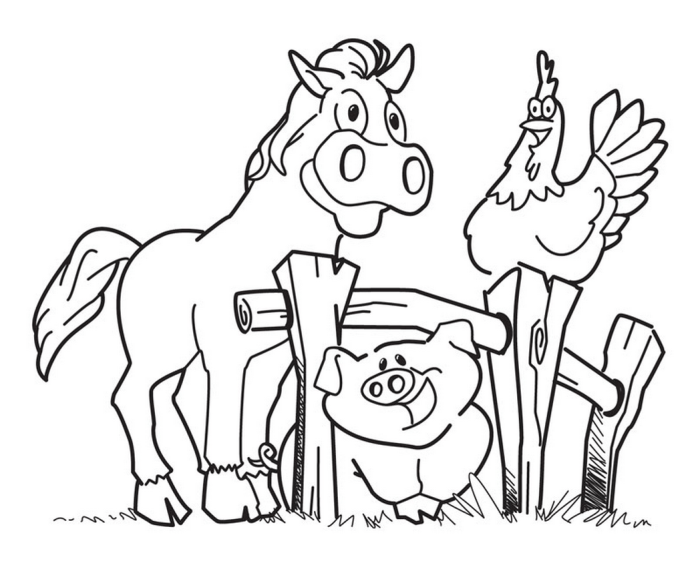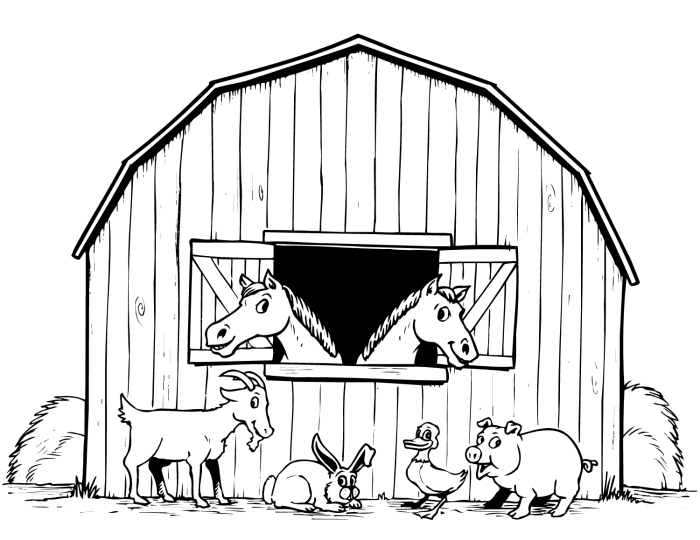Popularity and Trends

Free coloring pictures of farm animals – Free coloring pages featuring farm animals maintain consistent popularity as a creative activity for children and adults alike. Their enduring appeal stems from the inherent charm of these animals, their relatability, and the ease with which they can be depicted in a simple, appealing style suitable for coloring. This popularity is further fueled by readily available online resources offering free printable options.The popularity of farm animal coloring pages is demonstrably high, though precise quantitative data across all platforms is difficult to obtain without access to proprietary analytics from major coloring page websites and search engines.
However, anecdotal evidence from numerous websites dedicated to printable coloring pages, along with the persistent presence of farm animal coloring books in retail stores, strongly suggests significant and sustained demand.
Seasonal Trends in Searches
Searches for farm animal coloring pages exhibit some seasonal variation, although the fluctuations are generally not dramatic. Increased searches may be observed during periods associated with increased family time and children’s activities, such as summer vacations and school holidays. Conversely, search volume might slightly decrease during peak school semesters. However, this trend is not universally consistent and can be influenced by other factors, including the release of new children’s media featuring farm animals or related marketing campaigns.
A more thorough analysis would require access to search engine data, which is typically proprietary.
The readily available, sanitized images of farm animals—cows, pigs, sheep—offered in free coloring pictures often mask the brutal realities of industrial agriculture. This sanitized view contrasts sharply with the often more visceral depictions found in resources like wild animal coloring pages , which, while not explicitly political, can offer a glimpse into the untamed world these farm animals are ultimately derived from.
The stark difference highlights the carefully constructed narrative surrounding our food systems.
Comparison to Other Animal Themes
Farm animal coloring pages compete within a broader market of animal-themed coloring pages. While precise comparative data is unavailable publicly, it’s reasonable to assume that popular animals like cats, dogs, and dinosaurs likely see higher search volumes overall due to their broader cultural appeal and prevalence in children’s media. However, farm animals hold a significant niche, especially among younger children, due to their association with familiar imagery from storybooks and educational materials.
The popularity of specific farm animals also varies; for example, cows and pigs may be more commonly depicted than less visually striking animals like sheep or goats.
Search Volume Over Time for Different Farm Animals
The following table provides a hypothetical representation of search volume trends. Note that this data is illustrative and not based on actual search engine statistics, which are usually confidential. Real-world data would vary based on the search engine, geographic location, and specific search terms used. The numbers represent a relative scale, not absolute search counts.
| Animal | Q1 (Jan-Mar) | Q2 (Apr-Jun) | Q3 (Jul-Sep) | Q4 (Oct-Dec) |
|---|---|---|---|---|
| Cows | 100 | 120 | 150 | 110 |
| Pigs | 80 | 90 | 110 | 90 |
| Sheep | 60 | 70 | 80 | 70 |
| Chickens | 70 | 80 | 100 | 80 |
Illustrative Techniques and Image Quality

The effectiveness of farm animal coloring pages hinges significantly on the illustrative techniques employed and the resulting image quality. A well-executed illustration can engage children and adults alike, encouraging creativity and relaxation, while a poorly executed one may be unappealing and frustrating. This section examines various illustrative techniques, compares high- and low-quality examples, and analyzes the impact of line weight and detail on overall engagement.Illustrative techniques commonly used in farm animal coloring pages range from simple line art to more complex styles incorporating watercolor effects.
Line art, characterized by its clean lines and absence of shading or color, is prevalent due to its simplicity and ease of printing. Watercolor styles, on the other hand, offer a more textured and expressive approach, although they require more intricate line work to accommodate the washes of color. Other styles may incorporate simplified cartooning, realistic depictions, or even a combination of approaches.
The choice of style depends largely on the target audience and the overall aesthetic desired.
Line Art Styles and their Variations
Line art is a fundamental technique in coloring pages. Variations in line weight and detail significantly impact the final product. Thicker lines provide a bolder, more defined image, suitable for younger children who may have difficulty staying within thinner lines. Thinner lines, conversely, allow for more intricate detail and a more refined aesthetic, appealing to older children and adults.
A high-quality line art coloring page will feature clean, consistent lines, avoiding jagged edges or inconsistencies in thickness. A low-quality example might exhibit wavering lines, gaps, or overlaps, making it difficult to color within the boundaries. For instance, a high-quality pig illustration might have smoothly curved lines defining its body, while a low-quality version might show jagged, uneven lines that make coloring a frustrating experience.
Comparison of High- and Low-Quality Illustrations
Consider two examples: a high-quality coloring page depicting a cow might showcase meticulously rendered details, such as individual hairs in the cow’s coat, subtly varied line weights to suggest depth and form, and a clear distinction between different parts of the animal (legs, body, head, tail). In contrast, a low-quality illustration might depict the same cow with simplistic, poorly defined shapes, lacking detail and exhibiting uneven lines.
The overall impression would be one of crudeness and lack of refinement. The high-quality image invites careful coloring and appreciation of the detail, whereas the low-quality image might be quickly dismissed as uninteresting or difficult to work with.
Effectiveness of Line Weight and Detail
The choice of line weight directly influences the coloring experience. Heavier line weights are easier to follow, making them ideal for younger children or those with less experience in coloring. However, they may result in a less nuanced and detailed image. Lighter line weights, conversely, allow for more delicate details and shading but require greater precision and skill from the colorer.
The level of detail also plays a crucial role. A highly detailed image provides a more engaging experience, but may also be overwhelming for younger children. A balance must be struck between detail and simplicity to create an appealing coloring page that caters to the target audience. For example, a coloring page for toddlers might feature simple shapes and thick lines, while one for older children or adults might include more intricate details and thinner lines.
Example: Simple Line Art Pig Coloring Page
Imagine a pig drawn using simple line art. The body is a rounded oblong shape, with two smaller ovals for the ears, placed atop the head. The legs are represented by four short, slightly curved lines, and the tail is a short, curly line. The snout is a small triangle, and the eyes are two small circles.
The lines are consistently thick, approximately 3mm wide, suitable for easy coloring by young children. No shading or intricate details are included, ensuring the simplicity and ease of coloring are prioritized. The overall design is clear, balanced, and suitable for printing on standard paper.
Accessibility and Inclusivity: Free Coloring Pictures Of Farm Animals

Creating inclusive and accessible coloring pages is crucial for ensuring that all children, regardless of their abilities or backgrounds, can participate in this enjoyable and educational activity. Accessibility goes beyond simply providing a printable image; it involves considering the diverse needs and experiences of children with disabilities and promoting representation of diverse animal characteristics. This ensures that coloring pages are not only fun but also contribute to a more equitable and inclusive environment for all.Inclusive coloring pages promote positive self-esteem and a sense of belonging among children with disabilities.
By adapting designs and formats, we can make the activity accessible to a wider range of children, fostering creativity and self-expression for everyone. Furthermore, the inclusion of diverse animal representations helps to challenge stereotypes and broaden children’s understanding of the natural world.
Methods for Creating Accessible Coloring Pages for Children with Disabilities, Free coloring pictures of farm animals
Several strategies can enhance the accessibility of coloring pages for children with various disabilities. For example, children with visual impairments may benefit from raised-line drawings or tactile coloring materials. Children with motor skill challenges might find larger print or simplified designs easier to manage. Providing alternative formats, such as digital coloring pages that can be manipulated using assistive technology, further expands accessibility.
Consideration should also be given to color contrast to aid children with visual processing difficulties. High contrast between the lines and the background is essential for optimal visibility.
Diverse Animal Representations in Coloring Pages
Representing a wide variety of farm animals is important for promoting inclusivity and challenging stereotypes. This includes depicting animals with different breeds, sizes, colors, and physical characteristics. For example, showcasing animals with disabilities, such as a pig with a limp or a cow with a unique marking, can normalize differences and promote understanding and empathy. Including animals from different cultural backgrounds and contexts can further enhance the diversity of the coloring pages.
Example of an Inclusive Farm Animal Coloring Page
The coloring page depicts a vibrant farmyard scene. A large, speckled brown hen with one slightly shorter leg pecks at the ground alongside a fluffy white lamb with one ear slightly drooping. A sleek black pig with a distinctive curly tail playfully nudges a spotted calf with unusually long eyelashes. In the background, a slightly smaller than average brown horse with a unique white blaze on its forehead grazes peacefully, next to a goat with a short, stubby horn.
The overall color scheme is bright and cheerful, using a range of contrasting colors to ensure accessibility for children with visual impairments. The lines are bold and thick, making them easy for children with fine motor skill challenges to color. The animals are depicted in a playful and friendly manner, fostering a sense of joy and inclusivity.
The page avoids using overly complex or detailed designs, ensuring it remains accessible to a wide range of abilities.
